Make an enquiry

Soulnote M-3 Monoblock Power Amplifier
Enquiry Submitted!
Make an Offer

Soulnote M-3 Monoblock Power Amplifier
Offer Submitted!





Soulnote M-3 Monoblock Power Amplifier
Soulnote M-3 Monoblock Power Amplifier
Black
22 Saint Kilda Road
22 Saint Kilda Road
Suite 2.02
St Kilda VIC 3182
Australia



Soulnote M-3
MONOBLOCK POWER AMPLIFIER – available in Premium Silver / Premium Black
Newly incorporated industrial grade can-type output transistors to achieve a perfect non-negative feedback single push-pull structure.
Monoblock power amplifier that lets high-end speakers around the world provide playback bursting with emotion.
TECHNOLOGY

A single push-pull output stage with 4-stage Darlington can-type transistors
We decided that single-end and single push-pull output was indispensable in creating an emotional musical experience, thus eliminating the "blurring in the microscopic time domain" so often symbolized by improvements in sound quality through high-end clocks.
Nevertheless, we still had to overcome the relatively low levels of current provided by the typical single push-pull configurations. As a result, in the M-3 we introduced industrial grade can-type output transistors with a relatively small Cob and large current flow. The driver stage incorporates the same output stage transistors used in the A-2 to easily drive these large capacity cans for a total of four Darlington construction stages.
Bus bars with copper plate heat sinks
The main heat sink uses small, lightweight copper plate heat sinks – a rarity in conventional high power amplifiers. This heat sink also doubles as a bus bar to power the can transistors, while the can-type transistor terminals pass through the bus bar and are mounted directly on the board underneath. This eliminates wiring – the Achilles' heel of can-type transistors – while also removing instability from inductance components and deteriorations to sound quality caused by insulating sheet dumps in the device. Additionally, the heat sink is physically isolated from the chassis, which significantly impacts sound quality aspects such as transparency and providing a feeling of openness. This way, this heat sink kills three birds with one stone.

Voltage amplification stage
The voltage amplification stage employs non-negative feedback differential circuits (new Type-R circuits) redesigned for power amplifiers.
Only a single transistor is used to fully amplify the emitter follower, voltage, and differential circuits without any gain. The load impedance in this transistor is a "GND one-stage amplification single-end non-negative feedback circuit" that connects only to the GND. These new Type-R circuits were created using only 4 bipolar junction transistors and 10 resistors to extract ideal full swing output across a wide spectrum, even though this configuration is primarily the same as that used for single ended tube amplifiers. This ideal non-negative feedback circuit could easily be dubbed a reference circuit for how well it performs.
Extremely simple construction
The M-3 is where we discovered that large current power amplifiers should be dedicated to a single function. It features just one set of input terminals and speaker terminals. It is a single-function monoblock power amplifier with no selectors or attenuators. The signals input from the XLR terminals travel directly to the base of the first stage transistors, undergo single stage amplification, and are output via a single push-pull circuit. The only available operation is the power switch. As expected, the unit contains no unnecessary circuits or components like microcontrollers, etc.

Ultra-low loss 1600 VA non-epoxy resin-filling toroidal power transformer
We developed a large power transformer that can be carried by one person alone. This giant power transformer is mounted vertically to the front panel so that any leakage flux travels parallel to the circuit boards, and it is suspended on titanium washers and connected to a spike to ensure that harmful vibrations are not transmitted to the chassis.

High-speed non-negative feedback power supply
The commutating capacitors use specially selected 470 uF high resistance, small capacity, low magnification foil filter capacitors. Optimizing capacity according the number of capacitors used and minimizing the power supply load further improves real regulation in this heavy-duty power supply transformer. The rectifier diode uses newly adopted SiC diodes with the latest specs that reinforce the maximum input current value. This creates an unimaginably powerful and fast power supply structure.
Amplifier container completely separate from the main body, each grounded by three spikes
Three spikes ground both the main body and the amplifier container for a total of six spikes in the M-3. While these two components are completely physically separate, the power supply line from the power supply transformer has been shortened to eliminate any negative impacts as a result of vibrations and leakage from the transformer. This truly ideal construction results in an incredulous sound quality that can be experienced by attaching or removing the transportation screw. And of course, the audio board, AC adapter, speaker terminals, input terminals, and base plate are all non-rigid parts.
|
Maximum output |
160W (4Ω) |
|
Total harmonic distortion |
0,1% (1W) |
|
Frequency characteristic |
2Hz ~ 200kHz (±1dB) |
|
Input sensitivity / impedance |
1V / 25kΩ |
|
Gain |
22dB |
|
Power voltage |
230V AC 50Hz |
|
Power consumption |
110W |
|
Maximum external dimensions |
Main unit: 340(W) × 251(H) × 512(D)mm |
|
Weight |
31kg |
|
Included accessories |
Special speaker cable, Special rack, Power cable |
User Reviews
We care about your experience with HeyNow Hi-Fi, and we’re here to make the warranty process as smooth as possible.
Your warranty is handled directly by the Australian importer. By submitting this form, we’ll coordinate the process for you and keep you updated every step of the way. Important: Shipping fees are not included as part of your warranty coverage.
If your HeyNow Hi-Fi purchase isn’t working as it should, click here to lodge a warranty claim.
Should you have any questions, feel free to contact us https://www.heynowhifi.com.au//pages/contact



